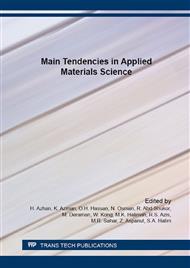p.27
p.37
p.45
p.52
p.58
p.63
p.69
p.75
p.80
Reactivity Study of LaSrCoFeO3 - Ba(Ce,Zr)O3 Composite Cathode Material
Abstract:
This paper reports on the reactivity study of composite cathode materials that comprises different weight percent of La0.6Sr0.4Co0.2Fe0.8O3-α (LSCF) and BaCe0.54Zr0.36Y0.1O3-α (BCZY). BCZY and LSCF powders are both prepared by a sol-gel method using metal nitrate salts as precursor. In this work, three samples with different weight percent ratios of 30, 50 & 70% of LSCF to BCZY were used and denoted as sample A1, A2 and A3, respectively. The powder mixtures of all samples were calcined at temperature of 1000 °C for 10 hours in an air. The phase formation of the samples was identified by X-ray diffractometer (XRD). As a comparison, XRD measurements for the LSCF and BCZY powders were also conducted individually, and their single-phase XRD pattern was used to identify the formation of undesired secondary reaction of the powdered mixture. The analysis of room temperature XRD data revealed that A1, A2 and A3 samples exhibit a complete solid solution between the crystal structures of LSCF cathode and BCZY electrolyte. The peaks can be indexed to (110), (020), (202), (220), (132), (224), (332) that belong to the LCSF phase and (110), (200), (211), (220), (310), (222) peaks that fit to the BCZY phase. No additional reaction products or secondary phases were observed indicating that up to 1000 °C, the prepared mixture formed a decent LSCF-BCZY composite. The average values of the lattice parameters for all the samples confirmed their phases were stable with the increasing BCZY content. Thus, it found that the LSCF is compatible with BCZY to form LSCF-BCZY composite for potential cathode material.
Info:
Periodical:
Pages:
58-62
Citation:
Online since:
March 2016
Keywords:
Price:
Сopyright:
© 2016 Trans Tech Publications Ltd. All Rights Reserved
Share:
Citation:


